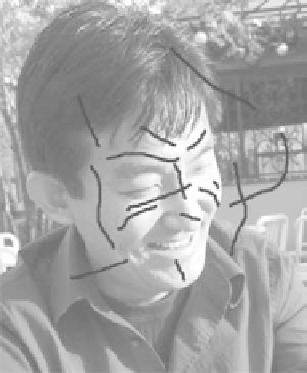Biomedical Engineering Reference
In-Depth Information
(a)
(b)
Figure 9.
Image inpainting using level set methods: (a) corrupted image; (b) restored
image after the fast marching-based inpainting. See attached CD for color version.
Front movement provides distance information and the normal direction,
which can be effectively used as a reference for image inpainting [24]. An example
is shown in Figure 9.
The signed distance is important information that could control front move-
ment to the goal shape. This would help make the Level Set Metamorphosis a
simple procedure. Since the front is not moving in only one direction, the narrow-
band method has to be used. An example is shown in Figure 10, where (a) is the
initial shape and (f) is the given goal state. Using the signed distance map of (f),
the initial shape in (a) is driven to the final shape (f). The interim steps of the shape
changing procedure are shown in (b)-(e). More details about these methods and
more interesting examples can be found in [11].
4.
ACTIVE CONTOURS IN THE LEVEL SET FRAMEWORK
From the previous section, the reader may find that the level set method can
be applied directly to image processing tasks. The method is closely connected
with the active contour or deformable model method, which has been employed as
a powerful tool for image analysis. Active contours are object-delineating curves
or surfaces that move within two- or three-dimensional digital images under the
influence of internal and external forces and user-defined constraints. Since their
introduction by Kass et al. [47], these algorithms have been at the core of one of the
most active and successful research areas in edge detection, image segmentation,


